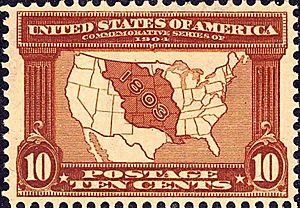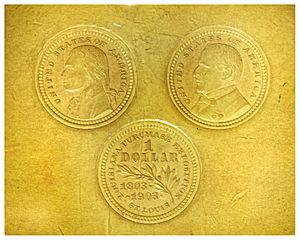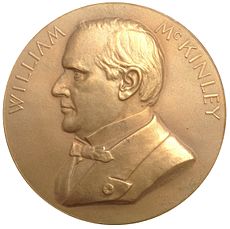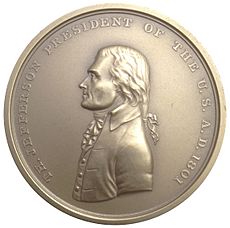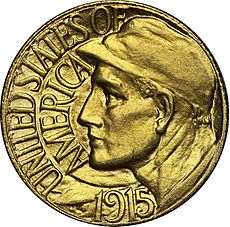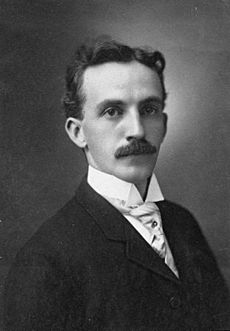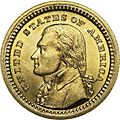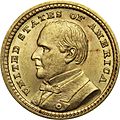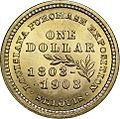Louisiana Purchase Exposition gold dollar facts for kids
| United States | |
| Value | 1 US dollar |
|---|---|
| Mass | 1.672 g |
| Diameter | 15 mm |
| Edge | Reeded |
| Composition | |
| Gold | 0.04837 troy oz |
| Years of minting | 1903 (some pieces struck in 1902 with 1903 date) |
| Mintage | 125,000 of each type minted; 35,000 total coins distributed, remainder melted. |
| Mint marks | None. All pieces struck at Philadelphia Mint without mint mark. |
| Obverse | |
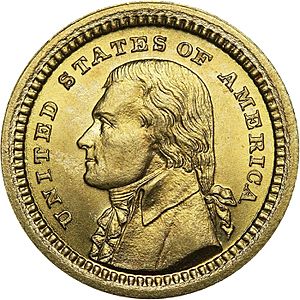 |
|
| Design | Thomas Jefferson |
| Designer | Charles E. Barber, after a medal by John Reich |
| Design date | 1903 |
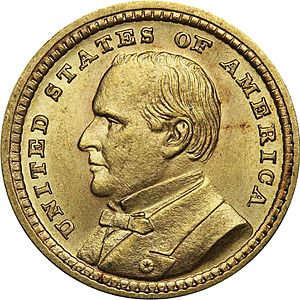 |
|
| Design | William McKinley |
| Designer | Charles E. Barber, after a medal by himself |
| Design date | 1903 |
| Reverse | |
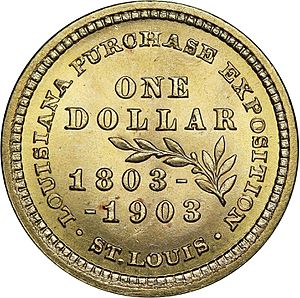 |
|
| Design | Reverse common to both varieties |
| Designer | Charles E. Barber |
| Design date | 1903 |
The Louisiana Purchase Exposition gold dollar is a special coin from 1903. It was made to remember the Louisiana Purchase Exposition, a big fair held in St. Louis in 1904. These coins were designed by Charles E. Barber, the main engraver at the United States Mint.
There were two types of these gold dollars. One showed Thomas Jefferson, who was president when the Louisiana Purchase happened. The other showed William McKinley, who was president when the fair was planned but was sadly assassinated before it opened. These were the first gold commemorative coins ever made in the United States.
People who organized the fair wanted these coins to help raise money. Congress allowed 250,000 of these coins to be made. Each coin was sold for $3. You could buy them as just a coin, or sometimes they came in jewelry or on a spoon. However, the coins did not sell very well. Most of them were later melted down. Today, these coins are worth much more, usually hundreds or even thousands of dollars, depending on their condition.
Contents
The Louisiana Purchase Story
The Louisiana Purchase was a huge land deal that doubled the size of the United States. Before this, much of the land near the Mississippi River was explored by the French. In 1682, a French explorer named René-Robert Cavelier, Sieur de La Salle claimed this vast area for France. He named it Louisiana after the French king, Louis XIV.
Later, France secretly gave this land to Spain. But in 1799, Napoleon came to power in France. He wanted to rebuild the French empire and got Louisiana back from Spain. American President Thomas Jefferson found out about this in 1801. He worried that France might close the important port of New Orleans to American ships.
Jefferson sent James Monroe to France to buy New Orleans and the land around it. But Napoleon surprised them! He offered to sell the entire Louisiana territory. He was facing problems in Haiti and feared the British might try to take New Orleans. So, he decided to sell the whole area to the U.S.
In 1803, the U.S. agreed to buy about 828,500 square miles of land for about $15 million. This was a huge amount of land for a very low price! The deal was signed on April 30, 1803. Even though some people wondered if the Constitution allowed such a big purchase, the Senate approved it. The United States officially took control of the land two months later.
To celebrate 100 years since this important event, Congress decided to hold a big fair. President William McKinley signed the law for the fair on March 3, 1901. Sadly, President McKinley was assassinated later that year.
Making the Commemorative Coins
The idea for the Louisiana Purchase Exposition gold dollar was approved by Congress on June 28, 1902. President Theodore Roosevelt signed the bill. This law allowed 250,000 gold dollar coins to be made for the fair organizers. The design of the coins was left up to the Secretary of the Treasury.
It was decided to make two different designs for the coins. This was suggested by Farran Zerbe, a coin collector and promoter. He believed that having two designs would help sell more coins. Zerbe was very involved in selling special commemorative coins for many years. He was the only person in charge of selling the Louisiana Purchase dollars.
The main engraver, Charles E. Barber, started working on the coin designs in September 1902. One side of the coin would show President McKinley, and the other would show President Jefferson. The back of both coins would be the same. It would show the value "1 DOLLAR" and the dates "1803" and "1903" with an olive branch.
The Philadelphia Mint started making the coins in December 1902. They made 75,080 gold dollars that month. All of them were dated 1903, even though some were made in 1902. This was unusual but not unheard of. In January 1903, they made another 175,178 coins. A small number were set aside for testing.
The very first 100 coins of each design were made with a special "proof" finish. These were given to important people and Mint officials. They were not sold to the public. These were the first gold commemorative coins ever made by the U.S. Mint.
Coin Designs and Opinions
Charles Barber based the design for the Jefferson coin on an older medal made by an engraver named John Reich. For the McKinley coin, Barber used his own design from a medal he had made of McKinley. President McKinley had actually posed for Barber when that medal was created. The back of both coins had the value, a message about the fair, and an olive branch.
Some people really liked the coins. A coin dealer named B. Max Mehl thought they were "the most attractive of all of our commemorative gold dollars." However, not everyone agreed. Some critics felt that Barber's image of Jefferson looked too much like Napoleon Bonaparte. They also noted that the olive branch on the back might represent the peaceful way the land was acquired.
An art historian named Cornelius Vermeule thought these coins, and others made around the same time, lacked excitement. He felt the faces and details were too flat. But he also noted that people at the time saw these coins as new and exciting. They hoped it meant that regular U.S. coins would start to show real people instead of just symbols. This eventually happened, starting with the Lincoln cent in 1909.
Selling the Coins and What Happened Next
The big fair in St. Louis finally opened on April 30, 1904, a year later than planned. It was one of the largest World's Fairs ever, covering a huge area. Millions of people visited the fair, which even inspired the famous song, "Meet Me in St. Louis."
The gold dollars were sold for $3 each at the fair. You could buy them as coins, or sometimes they were put into spoons or jewelry. Some of these items were soldered, which damaged the coins and lowered their value later. Farran Zerbe, the coin promoter, came up with these different ways to sell the coins.
Zerbe also tried to sell the coins to coin collectors. But many collectors thought $3 was too expensive for a dollar coin. Because of this, the coins did not sell very well. By November 1903, only about 10,000 coins had been sold. Most of these were bought by fair organizers and coin dealers.
Zerbe continued to sell the coins at his coin exhibits for years after the fair. Another coin dealer, B. Max Mehl, bought thousands of them from Zerbe for just a little more than their face value. Mehl then sold them through his mail-order business until the 1920s. In the end, only about 35,000 of the 250,000 coins were sold to the public. The remaining 215,000 coins were sent back to the Mint and melted down around 1914.
It's not known exactly how many of each type (Jefferson or McKinley) were melted. Some experts think slightly more McKinley coins were sold, while others believe more Jefferson coins were sold.
Even though Zerbe had promised to keep the price of the coins at $3, their value dropped to about $2 by late 1905. However, they slowly gained value again. By 1915, they were back to $3. Today, these coins are quite valuable. Depending on their condition, they can be worth from $500 to over $2,000.
Images for kids
See also
 In Spanish: Dólar conmemorativo de la Exposición Universal de San Luis para niños
In Spanish: Dólar conmemorativo de la Exposición Universal de San Luis para niños


